
3. Labour Demand
KAT.TAL.322 Advanced Course in Labour Economics
September 1, 2025
Labour demand
Firm decisions about how much labour to hire
Static model
Static model
Single factor input
Production function \(Y = F(L)\) where \(F^\prime > 0\) and \(F^{\prime\prime} < 0\)
\[ \max_{L} PF(L) - WL \]
FOC: \(F^\prime(L) = \frac{W}{P}\)
Downward-sloping labour demand
\[ \frac{\partial L}{\partial W} = \frac{1}{PF^{\prime\prime}(L)} < 0 \]
Static model
Two factor inputs: conditional factor demand
Production function \(Y = F(L, K)\) where \(F_L > 0, F_K > 0, F_{LL} < 0, F_{KK} < 0\)
Cost minimization problem: \(\min_{L, K} C(L, K) = WL + RK\) s.t. \(F(L, K) = \bar{Y}\)
Conditional demand: \(\bar{K}(W, R, \bar{Y})\) and \(\bar{L}(W, R, \bar{Y})\)
\[ \frac{F_L(\bar{L}, \bar{K})}{F_K(\bar{L}, \bar{K})} = \frac{W}{R} \quad\text{and}\quad F(\bar{L}, \bar{K}) = \bar{Y} \]
Static model
Two factor inputs: conditional demand elasticities
Own-price elasticities: \(\eta_W^L = \frac{\partial \ln \bar{L}}{\partial \ln W} < 0\) and \(\eta_R^K = \frac{\partial \ln \bar{K}}{\partial \ln R} < 0\)
Cross-price elasticities: \(\eta_R^L = \frac{\partial \ln \bar{L}}{\partial \ln R} > 0\) and \(\eta_W^K = \frac{\partial \ln \bar{K}}{\partial \ln W} > 0\)
Elasticity of substitution \(\sigma = \frac{\partial \ln\left(\frac{K}{L}\right)}{\partial \ln \left(\frac{W}{R}\right)} > 0\)
It is also possible to show that
\[ \eta_R^L = \sigma (1 - s) \quad \text{and} \quad \eta_W^L = -\sigma(1 - s) \]
where \(s = \frac{WL}{C}\) is labour share in total cost
Static model
Two factor inputs: unconditional factor demand
Second step: \(\max_{Y} PY - C(W, R, Y)\)
Solution: \(P = C_Y(W, R, Y^*), L^* = \bar{L}(W, R, Y^*), K^* = \bar{K}(W, R, Y^*)\)
Total elasticities decomposed into substitution and scale effects:
\[ \varepsilon_W^L = \color{#8e2f1f}{\eta_W^L} + \color{#288393}{\eta_Y^L \varepsilon_W^Y} < 0 \]
\[ \varepsilon_R^L = \color{#8e2f1f}{\eta_R^L} + \color{#288393}{\eta_Y^L\varepsilon_R^Y} \lessgtr 0 \]
Estimations of static model
Empirical strategy
Shephard’s lemma: \(\bar{L} = \frac{\partial C}{\partial W} \quad \Rightarrow \quad s = \frac{\partial \ln C}{\partial \ln W}\)
Specify functional form of \(\ln C\)
Example: translog cost function with \(n\) inputs
\[ \ln C = a_0 + \sum_{i = 1}^n a_i \ln W_i + \frac{1}{2} \sum_{i = 1}^n \sum_{j = 1}^n a_{ij} \ln W_i \ln W_j + \frac{1}{\theta} \ln Y \]
Regress input share \(s_i\) on \(\frac{\partial \ln C}{\partial \ln W_i}\)
Use estimated parameters to compute \(\sigma_{ij}\)
Estimations of static model
Main issues
Endogeneity
General equilibrium
Definitions of variables
Estimations of static model
Review by Hamermesh (1996) concludes that \(-\eta_W^L \in [0.15, 0.75]\).
If \(\eta_W^L = -0.30\) and given that \(s \approx 0.7\),
\[ \sigma = \frac{-\eta_W^L}{1 - s} \approx 1 \]
consistent with the Cobb-Douglas production function.
The review also suggests \(-\varepsilon_W^L \approx 1 \Rightarrow\) large scale effect.
Dynamic model
Dynamic model
Non-wage labour costs
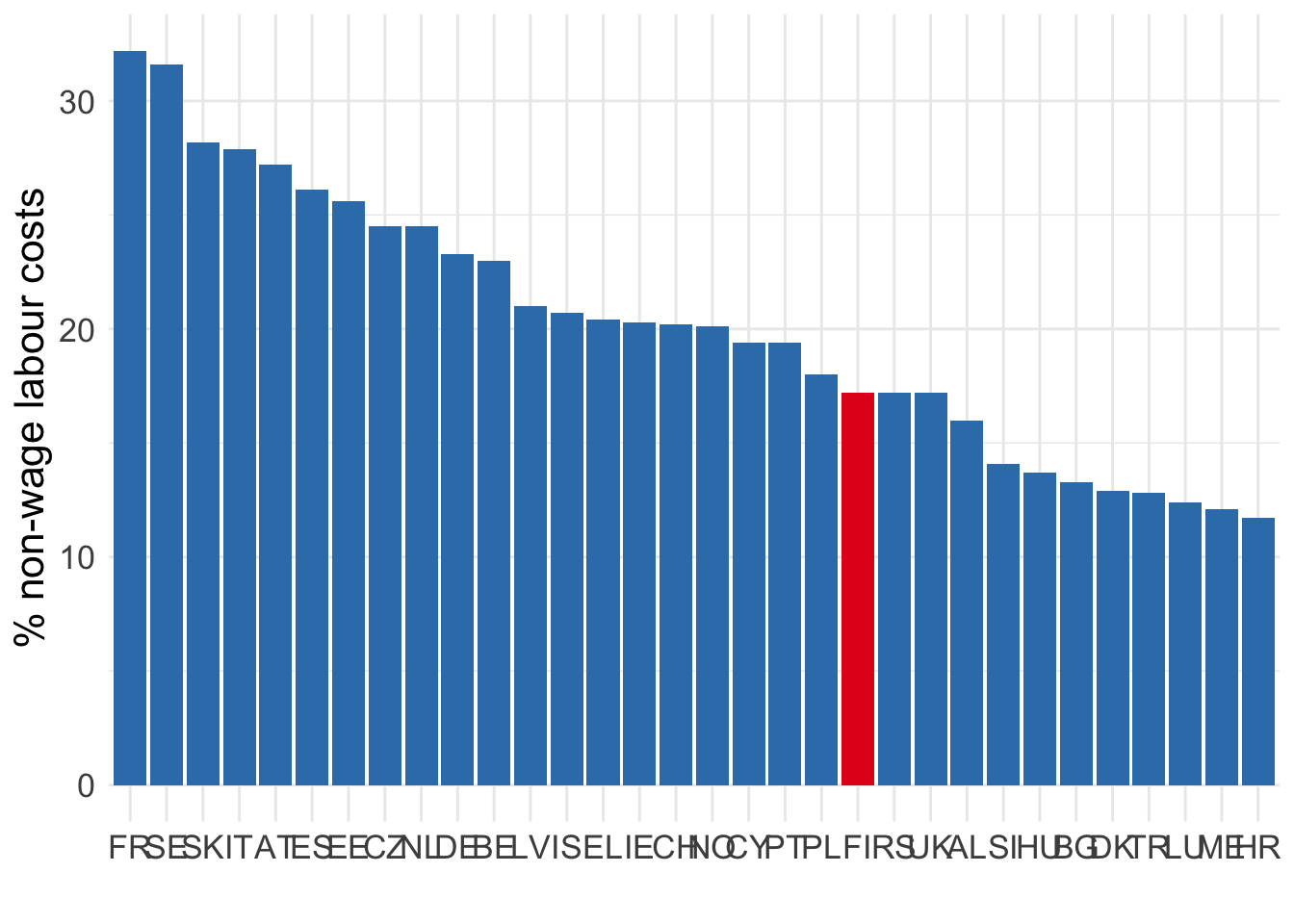
Source: Eurostat
Dynamic model
Adjustment costs
Quadratic cost: \(C\left(\Delta L_t\right) = b\left(\Delta L_t - a\right)^2\)
Asymmetric convex costs: \(C\left(\Delta L_t\right) = -1 + e^{a\Delta L_t} - a\Delta L_t + \frac{b}{2}\left(\Delta L_t\right)^2\)
Linear cost: \(C\left(\Delta L_t\right) = \begin{cases}c_h \Delta L_t & \text{if }\Delta L_t \geq 0\\-c_f \Delta L_t & \text{if }\Delta L_t \leq 0\end{cases}\)
Fixed cost
Dynamic model
Quadratic adjustment cost
For simplicity, assume single-input: \(Y_t = F(L_t)\)
Continuous time: \(\Delta L_t = \dot{L}_t = \frac{\text{d} L_t}{\text{d}t}\)
\[ \Pi_0 = \int_0^\infty \Pi_t dt = \int_0^\infty \left[F(L_t) - W_tL_t - \frac{b}{2}\dot{L}_t^2\right]e^{-rt}~\text{d}t \]
Euler equation: \(\frac{\partial \Pi_t}{\partial L} = \frac{\text{d}}{\text{d}t}\left(\frac{\partial \Pi_t}{\partial \dot{L}_t}\right)\)
\[ b\ddot{L}_t - rb\dot{L}_t + F'(L_t) - W_t = 0 \]
Dynamic model
Quadratic adjustment cost
Optimal path: \(\dot{L}_t = \gamma \left[L^* - L_t\right]\) where \(\gamma\) is decreasing in \(b\).

Figure 9.6 Optimal employment over a cycle (Nickell 1986)
Dynamic model
Linear adjustment cost
\[ \Pi_0 = \int_0^\infty \left[F(L_t) - W_tL_t - C(\dot{L}_t)\right]e^{-rt}dt \]
where \(C\left(\dot{L}_t\right) = \begin{cases}c_h \dot{L}_t & \text{if }\dot{L}_t \geq 0\\-c_f \dot{L}_t & \text{if }\dot{L}_t \leq 0\end{cases}\)
Optimal labour demand path is derived from
\[ \begin{cases}F'(L_t) = W_t + r c_h & \text{if }\dot{L}_t \geq 0 \\ F'(L_t) = W_t - r c_f & \text{if }\dot{L}_t < 0\end{cases} \]
Dynamic model
Linear adjustment cost
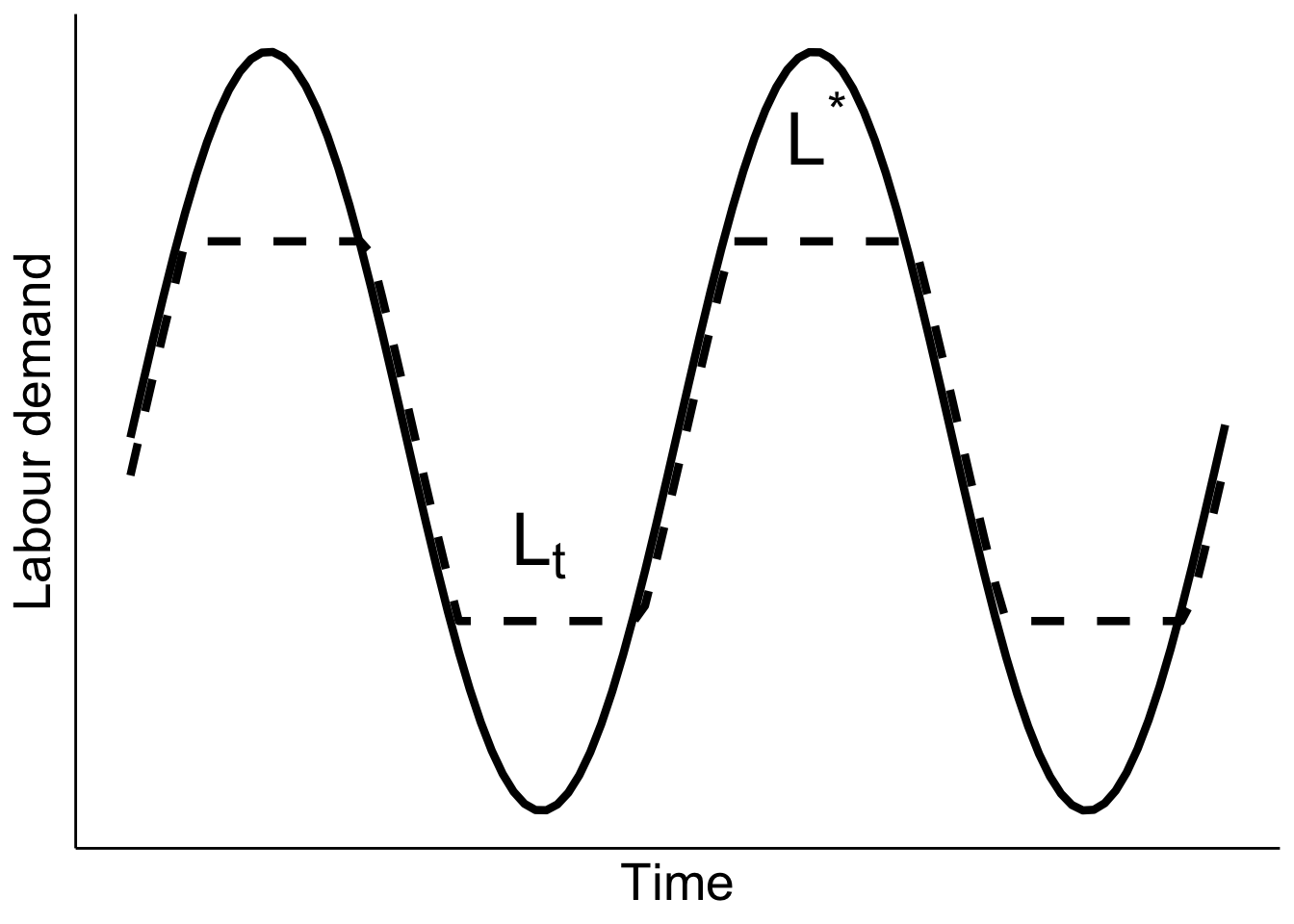
Figure 9.10 Optimal employment over the cycle (Nickell 1986)
Estimations of dynamic model
Empirical strategy for adjustment cost specification
Quadratic adjustment cost
Assume linear quadratic production function
Estimate \(L_{it} = \lambda L_{i, t - 1} + X_{it} \beta + \mu_i + \varepsilon_{it}\)
- Need to account for \(\text{Corr}\left(L_{i, t - 1}, \mu_i + \varepsilon_{it}\right)\)
Estimations of dynamic model
Some key results
Adjustments happen fast (1-2 quarters) (Hamermesh 1996, chap. 7)
Dynamic substitutes: utilization of capital increases with \(L_t - L^*\)
Hours of work are adjusted faster than number of workers
Figure 1 from Houseman and Abraham (1993) (adjustment to demand shocks)
Minimum wages and employment
Minimum wage and employment
What do the models we have considered so far predict?
lower labour demand (both compensated and uncompensated)
(maybe) higher labour supply
Not always supported by empirical evidence!
Minimum wage and employment
Card and Krueger (1994)
On April 1, 1992 minimum wage in New Jersey \(\uparrow\) from $4.25 to $5.05.
It stayed at $4.25 in Pennsylvania.

Minimum wage and employment
Card and Krueger (1994): Difference-in-differences
- Compare before and after in NJ:
\(E_{t1}^{NJ} - E_{t0}^{NJ}\) = 0.59 (se = 0.73)
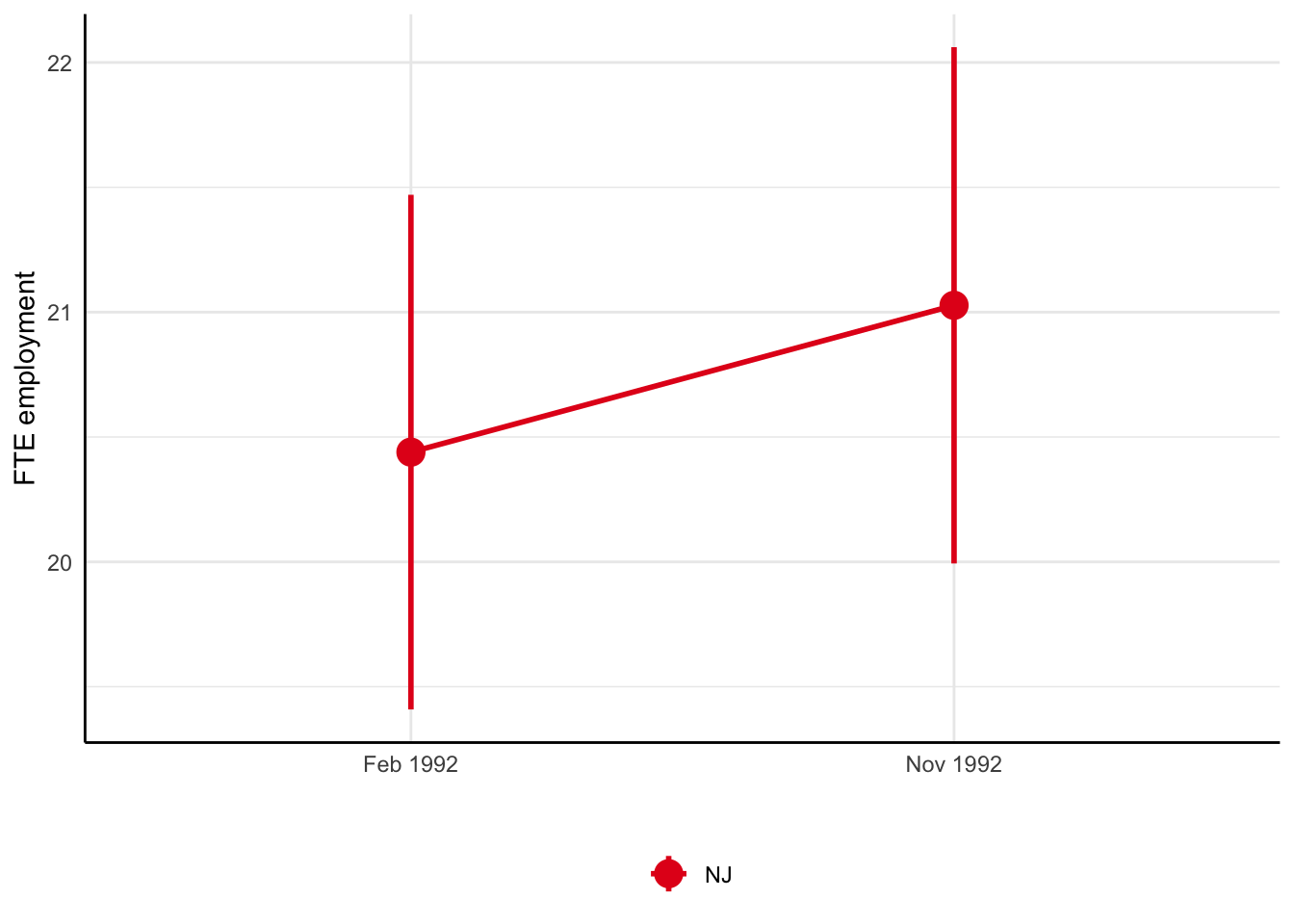
Minimum wage and employment
Card and Krueger (1994): Difference-in-differences
- Compare before and after in NJ:
\(E_{t1}^{NJ} - E_{t0}^{NJ}\) = 0.59 (se = 0.73) - Compare before and after in PA:
\(E_{t}^{NJ} - E_{t}^{PA}\) = -2.17 (se = 1.65)
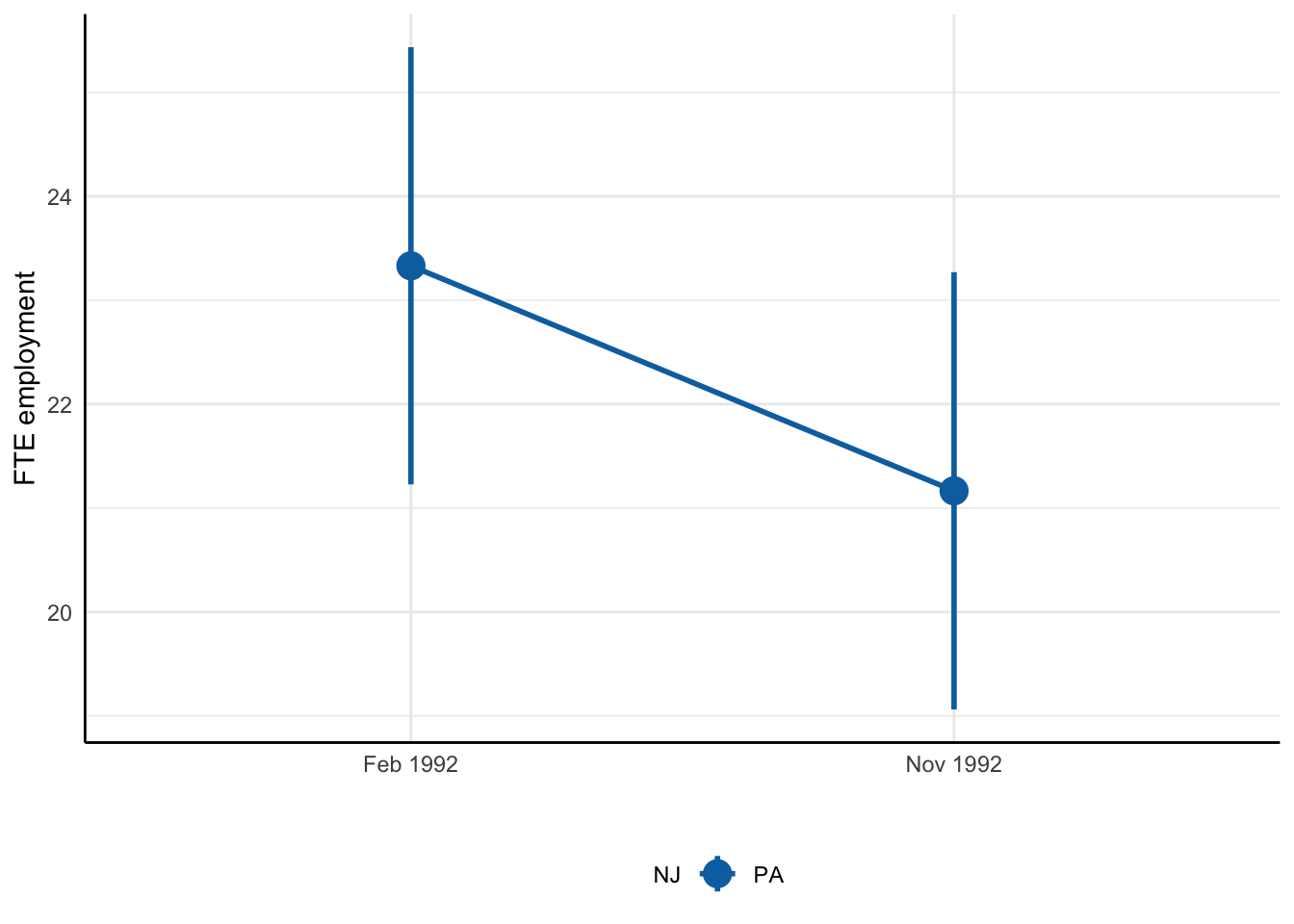
Minimum wage and employment
Card and Krueger (1994): Difference-in-differences
- Compare before and after in NJ:
\(E_{t1}^{NJ} - E_{t0}^{NJ}\) = 0.59 (se = 0.73) - Compare before and after in PA:
\(E_{t}^{NJ} - E_{t}^{PA}\) = -2.17 (se = 1.65) - Diff-in-diff:
\(\left(E_{t1}^{NJ} - E_{t0}^{NJ}\right) - \left(E_{t1}^{PA} - E_{t0}^{PA}\right)\) = 2.75 (se = 1.69)
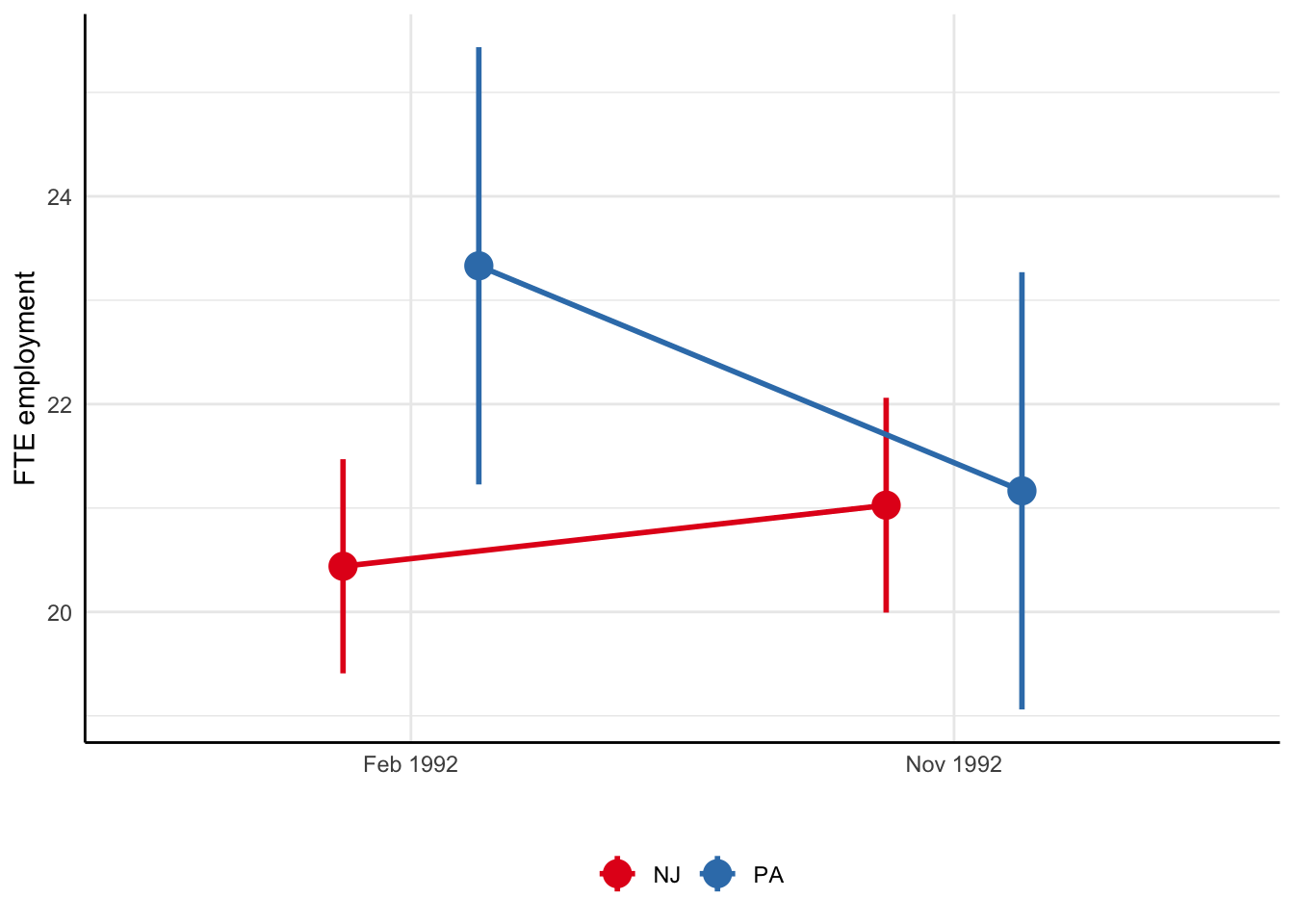
Minimum wage and employment
Jardim et al. (2022)
Seattle \(\uparrow\) min wage from $9.47 up to
- $11 in April 2015
- $13 in January 2016
Causal design:
- synthetic control: weighted average of other counties match pre-Seattle
- nearest neighbour matching: find “closest” worker outside of Seattle matching treated worker in Seattle
Minimum wage and employment
Jardim et al. (2022): synthetic control
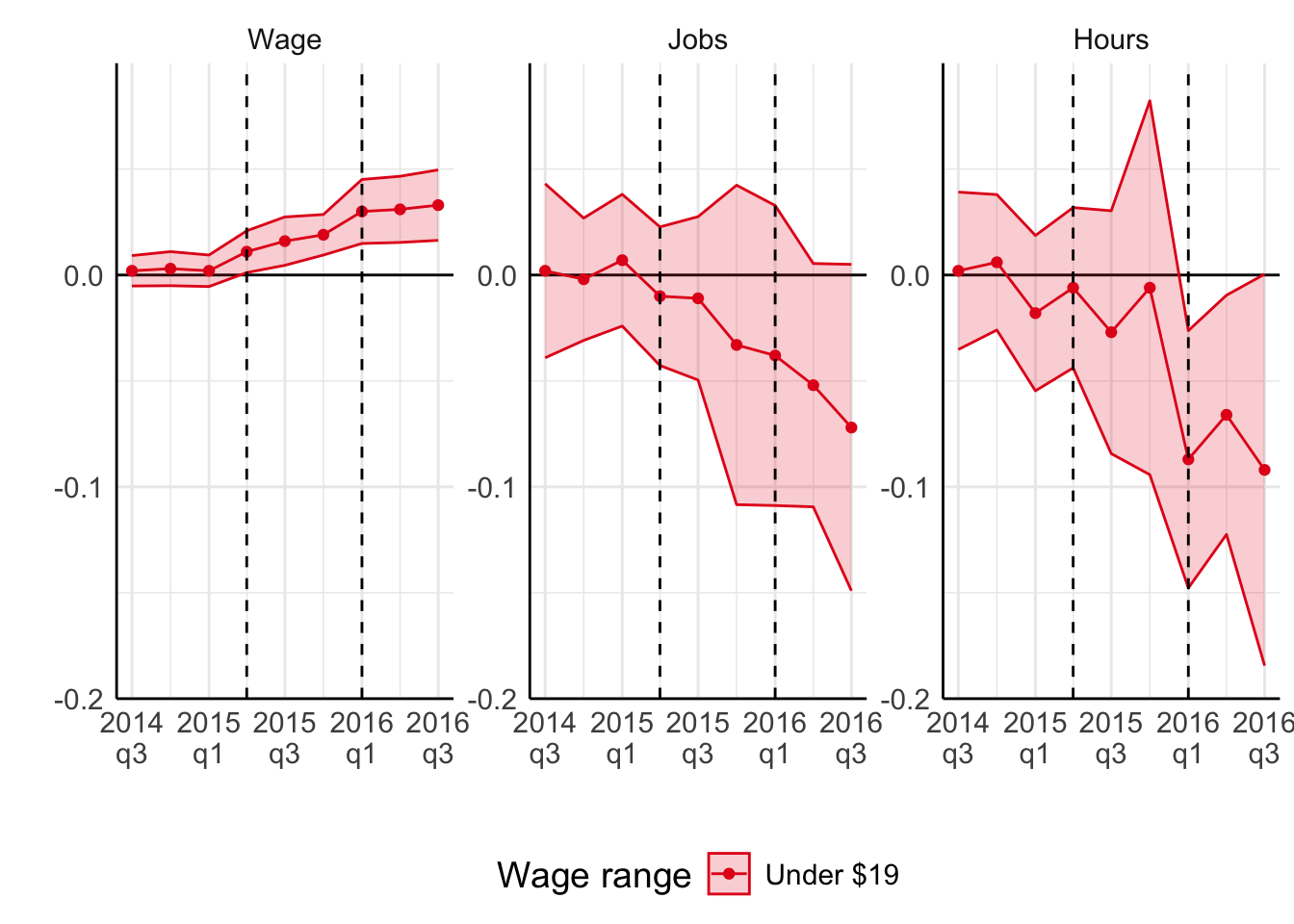
Minimum wage and employment
Jardim et al. (2022): synthetic control
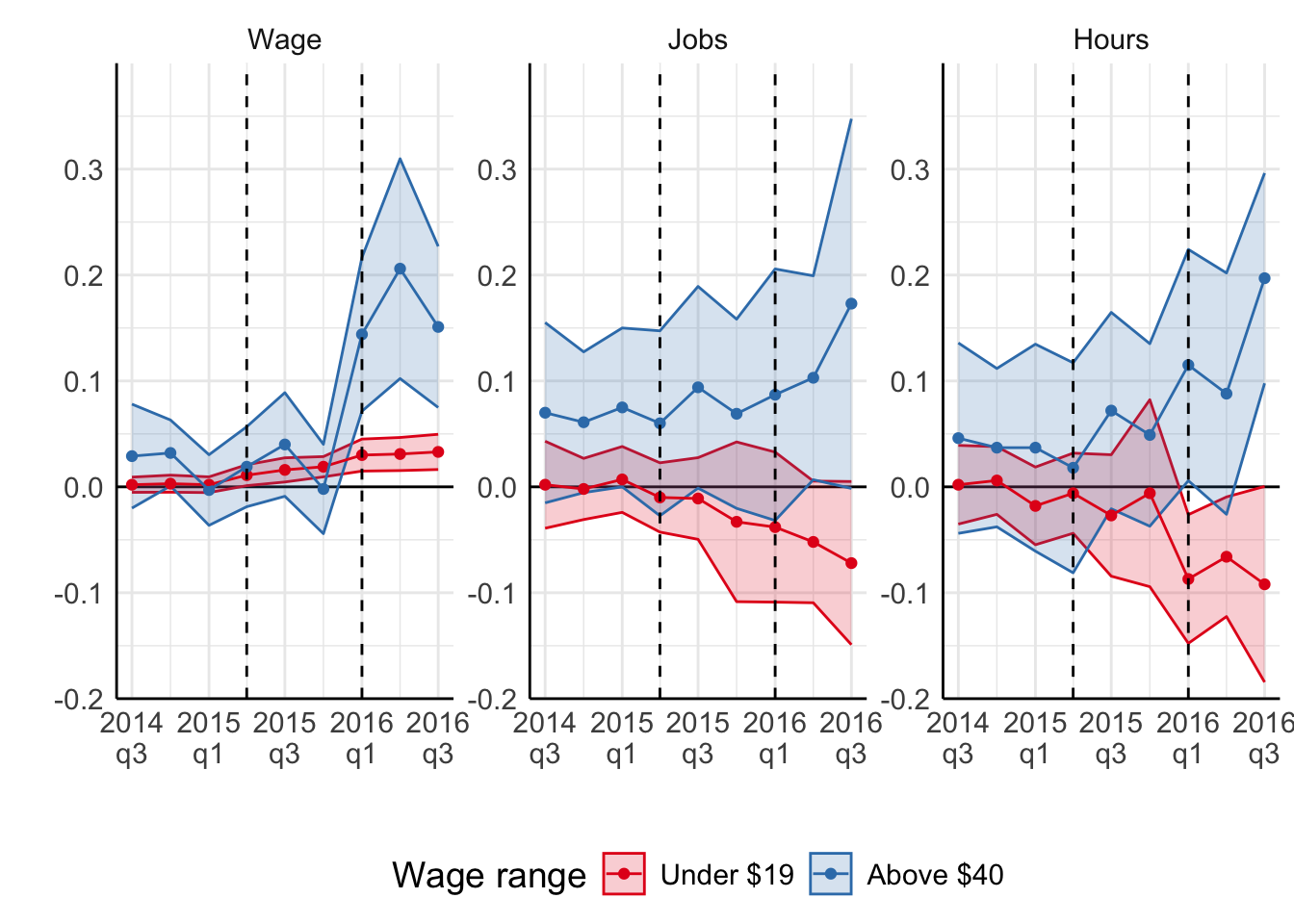
Minimum wage and employment
Jardim et al. (2022)
- Negative effect on hours worked stronger than on employment
- Experienced workers are better off
However,
- Potentially cascading effect
- Excluded large low-wage employers (like McDonald’s)
Reich, Allegretto, and Goddy (2017)
same policy + synthetic control = no change in employment
Minimum wage and other margins
Review in Clemens (2021)
- Price pass-through (Leung 2021; Renkin, Montialoux, and Siegenthaler 2022)
- Non-wage labour cost (Clemens, Kahn, and Meer 2018)
- Flexibility (theoretical Clemens and Strain 2020)
- Effort (Ku 2022; Coviello, Deserranno, and Persico 2022)
- Firm profit (Draca, Machin, and Van Reenen 2011; Bell and Machin 2018)
- Firm exit (Luca and Luca 2019; Dustmann et al. 2022)
Summary
Basic static and dynamic models of labour demand
Application to minimum wage policy
- Ongoing research (little consensus)
- Clear that basic models are insufficient
- Non-wage margins important and can interact with labour supply
Next lecture: Job Search on 03 Sep